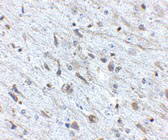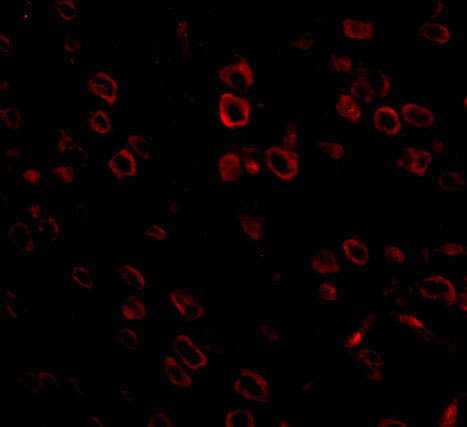FKBP15 Antibody
- SPECIFICATION
- CITATIONS
- PROTOCOLS
- BACKGROUND

Application
| WB, IHC-P, IF, E |
|---|---|
| Primary Accession | Q5T1M5 |
| Other Accession | NP_056073, 150010552 |
| Reactivity | Human, Mouse, Rat |
| Host | Rabbit |
| Clonality | Polyclonal |
| Isotype | IgG |
| Calculated MW | 133630 Da |
| Application Notes | FKBP15 antibody can be used for detection of FKBP15 by Western blot at 1 µg/mL. Antibody can also be used for immunohistochemistry starting at 2.5 µg/mL. For immunofluorescence start at 20 µg/mL. |
| Gene ID | 23307 |
|---|---|
| Target/Specificity | FKBP15; |
| Reconstitution & Storage | FKBP15 antibody can be stored at 4℃ for three months and -20℃, stable for up to one year. As with all antibodies care should be taken to avoid repeated freeze thaw cycles. Antibodies should not be exposed to prolonged high temperatures. |
| Precautions | FKBP15 Antibody is for research use only and not for use in diagnostic or therapeutic procedures. |
| Name | FKBP15 |
|---|---|
| Synonyms | KIAA0674 |
| Function | May be involved in the cytoskeletal organization of neuronal growth cones. Seems to be inactive as a PPIase (By similarity). Involved in the transport of early endosomes at the level of transition between microfilament-based and microtubule-based movement. |
| Cellular Location | Cytoplasm {ECO:0000250|UniProtKB:Q6P9Q6}. Cell projection, axon {ECO:0000250|UniProtKB:Q6P9Q6}. Early endosome. Note=Present in axons and neuronal growth cones. {ECO:0000250|UniProtKB:Q6P9Q6} |

Thousands of laboratories across the world have published research that depended on the performance of antibodies from Abcepta to advance their research. Check out links to articles that cite our products in major peer-reviewed journals, organized by research category.
info@abcepta.com, and receive a free "I Love Antibodies" mug.
Provided below are standard protocols that you may find useful for product applications.
Background
FKBP15 Antibody: FKBP15, also known as FKBP133, is a member of the FK506-binding protein family, a group of proteins initially identified as immunophilins, targets for the immunosupressant drugs FK506 and Rapamycin. FKBP15 is expressed in the developing nervous system and contains a domain similar to Wiskott-Aldrich syndrome protein homology region 1 (WH1) in addition to the FK506-binding protein motif. FKBP15 is distributed along the axonal shafts and partially co-localizes with F-actin in the growth cones of dorsal root ganglion neurons; overexpression of FKBP15 resulted in the number of filopodia in transfected neurons, suggesting that FKBP15 modulates growth cone behavior. FKBP15 has also been shown to associate with both microtubules and the actin filament systems and disruption of its expression by RNAi resulted in delayed transport of early endosomes in HeLa cells indicating that FKBP15 is also involved in the transport of early endosomes. At least three isoforms of FKBP15 are known to exist.
References
Nakajima O, Nakamura F, Yamashita N, et al. FKBP133: A novel mouse FK506-binding protein homolog alters growth cone morphology. Biochem. Biophys. Res. Comm.2006; 346:140-9.
Snyder SH, Lai MM, and Burnett PE. Immunophilins in the nervous system. Neuron1998; 21:283-94.
Viklund I-M, Aspenstrom P, Meas-Yedid V, et al. WAFL, a new protein involved in regulation of early endocytic transport at the intersection of actin and microtubule dynamics. Exp. Cell Res.2009; 315:1040-52.
If you have used an Abcepta product and would like to share how it has performed, please click on the "Submit Review" button and provide the requested information. Our staff will examine and post your review and contact you if needed.
If you have any additional inquiries please email technical services at tech@abcepta.com.













 Foundational characteristics of cancer include proliferation, angiogenesis, migration, evasion of apoptosis, and cellular immortality. Find key markers for these cellular processes and antibodies to detect them.
Foundational characteristics of cancer include proliferation, angiogenesis, migration, evasion of apoptosis, and cellular immortality. Find key markers for these cellular processes and antibodies to detect them. The SUMOplot™ Analysis Program predicts and scores sumoylation sites in your protein. SUMOylation is a post-translational modification involved in various cellular processes, such as nuclear-cytosolic transport, transcriptional regulation, apoptosis, protein stability, response to stress, and progression through the cell cycle.
The SUMOplot™ Analysis Program predicts and scores sumoylation sites in your protein. SUMOylation is a post-translational modification involved in various cellular processes, such as nuclear-cytosolic transport, transcriptional regulation, apoptosis, protein stability, response to stress, and progression through the cell cycle. The Autophagy Receptor Motif Plotter predicts and scores autophagy receptor binding sites in your protein. Identifying proteins connected to this pathway is critical to understanding the role of autophagy in physiological as well as pathological processes such as development, differentiation, neurodegenerative diseases, stress, infection, and cancer.
The Autophagy Receptor Motif Plotter predicts and scores autophagy receptor binding sites in your protein. Identifying proteins connected to this pathway is critical to understanding the role of autophagy in physiological as well as pathological processes such as development, differentiation, neurodegenerative diseases, stress, infection, and cancer.




